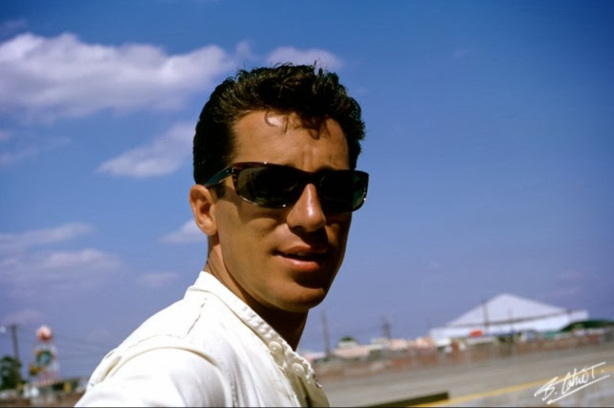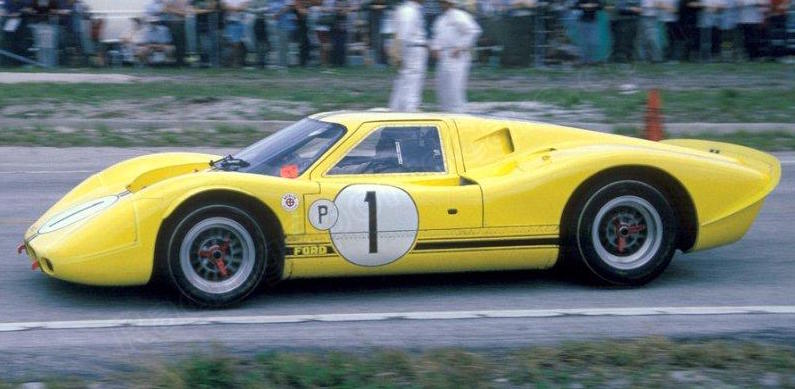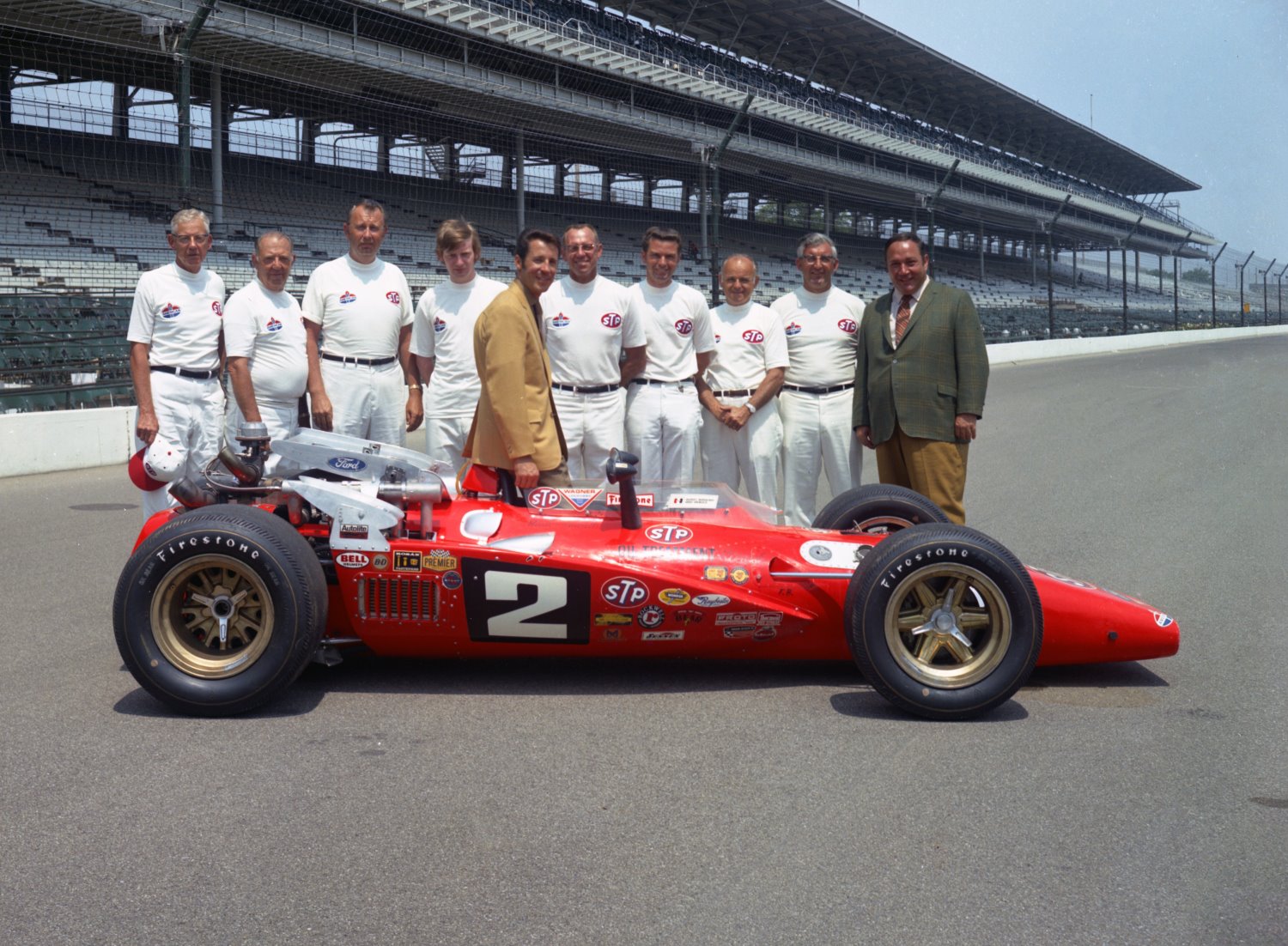Back in 1974 at Watkins Glen for the United States Grand Prix, I got the chance to sit down with Mario Andretti – in the Vel’s Parnelli Jones team’s section of the Glen circuit’s Technical Centre – and hear from him about his life and career that far. Mario came across as a hyper-competitive sportsman of great – and continuing – achievement and experience and, as a man, he was friendly and engaging and one who conducted himself in a gently distinguished (and highly impressive) manner.
To me, as a hopeless race reporter – by temperament far too shy and reserved ever to ask questions of anyone to whom I had not yet been introduced – the time Mario gave me that day seemed incredible. How had I got to him? Well, both Vel’s Parnelli designer Maurice Phillippe and team manager Andrew Ferguson were fellow Brits, ex-Team Lotus in England.
I knew both well from Lotus days, and it was Andrew who overcame my natural reticence – called me over and said “Hey Mario – here’s someone you ought to meet – he’s OK”. So, there at the Glen that day, I taped a long conversation with America’s finest Italian-born racing driver. And here’s part two of the feature story based upon it that I put together over the next few days. – Doug Nye
_____________________________________________________________________________________________
Continued from Part One…
The 1965 USAC big car season opened at Phoenix, Arizona, where Mario punched Dean’s lightweight roadster into the lead ahead of all the Lotus-based rear-engined cars. Then Johnny Rutherford spun in front of him and set him back to finish sixth.
Meanwhile, Clint Brawner had done a deal with John Zink, owner of the first Brabham Indy car, to copy it and build two updated Ford V8-powered replicas; one for the Dean team and one for Zink’s. The car was built, and it had scarcely turned a wheel before Andretti ran it so successfully at Indy. He went there with a second place at Trenton under his belt, and his fearless performance at the Speedway, swooping up within inches of the retaining wall out of the high-speed turns, finally made his name. It was Mario’s psychology which was right.
“Indy was, and is, a big myth in everybody’s mind. All the old-timers there look at ya and say ‘OK kid, don’t get too cocky, this is Indy’. So you think about it and you sit down and then you think ‘Shit, I’m not gonna get psyched. This is just a speedway like any other’. So you get prepared and you get it right and you do it right. Indy is special because everybody knows about it—you can’t do things there quietly—but otherwise, the Indy thing is a myth.
“What’s more difficult on the Championship circuit? I tell you, Trenton’s more difficult now. It’s 1½-miles and they’ve got a right-hand dogleg curve in the back-stretch. That dogleg’s a pig ’cos the cars can’t be set-up for it. You’ve gotta be so right through there. . .”
After his third place at Indy, which earned him $42,500, Mario won the Hoosier Grand Prix, was second in five more races and won the USAC Championship with 3,110 points. It had been his first full season, and he was the Rookie Champion. He was only 25 years old.
Mario Andretti circa 1966. Photo by Bernhard Cahier
In 1966, he won the title again, winning eight of the 15 qualifying races outright. At Indy, he qualified squarely on pole position with a new four-lap average of 165.899 mph and a one-lap record of 166.238 mph. He led for the first 16 laps until sidelined by valve trouble, to be classified a sorry 18th. Otherwise, his domination was complete.
Versatility is Andretti’s keynote. “I never retired from any form of racing’, he says, and early in 1967 he made his debut in NASCAR racing, taking on a Holman and Moody Ford Fairlane in the magic Daytona 500. He qualified for the race at a better than average 177 mph, but it was nothing startling. Then late in practice his red and grey Fairlane stormed around at 182 mph and some of the skeptical NASCAR faithful took a second look at the little man from Pennsylvania.
After a fierce late-race duel with Fred Lorenzen, it was Andretti who stormed to win the 500 —the first USAC and first non-NASCAR driver to do so. ‘Tis said that Kate Firestone was astonished by the man. “Look at him, he’s so teensy!”, she said. The Detroit News commented sagely, “…He’s toughsy and fastsy too…”.
Mario is one of the very few drivers ever to win the Indianapolis 500 (1969) and the Daytona 500 (1967) in their careers. He’s pictured here in the winning machine at Daytona.
Road racing was the next field to conquer. Mario had run a NART Ferrari in the Sebring 12-Hours the previous year, but a tragedy-darkened run ended in retirement. For ’67 he was paired with Bruce McLaren in the prototype 7-litre Ford Mark IV, and they won. Next day he was in Atlanta, running another 500-mile stock car race until repeated tyre blow-outs snuffed-out his drive against the wall. At Le Mans, he was paired with Lucien Bianchi, and their big Ford was running in second place in the small hours when the Belgian brought it in for refueling and a routine brake pad change.
The team of Bruce McLaren and Mario Andretti won the 12 Hours of Sebring in 1967 driving this prototype of the Ford GT 40 MkIV. Photo: George Boron.
It was then that Mario had one of his biggest frights; “The pads went in backward and cracked the disc. As I braked down into the Esses, right out of the pits, they just jerked the wheel out of my hands and the bitch car hit just about everything. I got to the side of the road when Roger McCluskey appeared, thought I was still in the wreck and smashed up trying to avoid it. Then Jo Schlesser came over the top and smashed his Ford as well oh, what a bitch that was…”.
Indy that year had Andretti on pole for the second time, but he was out of the race when the right front wheel parted company. He won seven Championship rounds and was leading the Rex Mays race at Riverside with only three laps to go when a stop for fuel cost him victory, and what would have been his hat-trick of National titles. Instead, A. J. Foyt topped the ratings.
In December Al Dean died, and Andretti took over the racing stable himself, still with Clint Brawner and Jim McGee preparing the Championship cars. Indy was a disaster as he started from row two and became the first retirement after only two laps, with engine trouble. He fought back in the rest of the series, winning three times and placed second 11 times. But the Riverside race cost him the title again, this time to Bobby Unser, by only 11 points. On road circuits, he had driven for Alfa Romeo at Daytona, and then Colin Chapman offered him a Gold Leaf Team Lotus drive in the Italian and US GPs. He was ruled out of the Italian race because he had a USAC event to do within 24 hours, but at Watkins Glen, he shook everybody by taking pole position in his first Formula 1 race. It all fell apart when the car’s nosecone fell to bits and its clutch failed.
Mario Andretti poses with the STP-sponsored team owned by Andy Granatelli (far right) that won the 1969 Indianapolis 500.
Then came 1969, backing from Andy Granatelli and STP and a first win in the Indy 500. During practice, Mario crashed very heavily in the Lotus 64, and he raced his ancient Hawk-Ford. “It was just a spare car you know, not even cleaned-off since Hanford. It had just two days of practice and was never out of third. I had to back-off in the race, it showed 260-degrees oil temperature, but we won. It was the first time … it was very satisfying”.
He went on to win eight more races and his third Championship. A works Ferrari ride into second place at Sebring meant a lot to him and with a brutish McLaren-Ford he struggled manfully to two good CanAm sports car placings. Meanwhile, he had great faith in four-wheel drive, and Colin Chapman pinned his Formula 1 hopes on the American’s faith. Unfortunately, “… it was worth a try, but it proved absolutely not worthy of road racing. Tyre development solved the traction problem, and anyway, the car’s straightaway speed was down. In a high-speed corner, the things were just fantastic, which is why they worked at Indy, but otherwise, no way…”.
At the Nurburgring, Mario had a short German GP. “I’d never practised with full tanks, an’ then I got a good start and was up with them. But the thing was bottoming on the bumps and then up over that Flugplatz, it bottomed so bad, I caught a wheel on the catch fence and took it off. I didn’t crash, I just slid to a stop but then Vic Elford came over in that McLaren and hit the wheel. He rolled upside down over a drop and I went down and held the car up off his arm on my shoulder and reached in and knocked the switches off. Poor guy, I felt kind of responsible, but what can you do, you know?”
In 1970 Mario was back in a Ferrari, this time a 512 in which he helped Vaccarella and Giunti to win at Sebring. The Granatellis backed him in the ill-conceived McNamara Championship car and in a similarly unsuccessful Formula 1 March. He was fifth in the USAC National Championship, which for him was a big fall. Then came the Formula 1 signing with Ferrari for 1971. “I enjoyed that to no end. It was something I had dreamed of since I was a kid at Lucca and when I won in South Africa it was the most satisfying thing I’d ever achieved.
“Psychologically it was a very great thing, and the win at Ontario was good too because those cars were the real t’oroughbreds. It’s who you beat that matters—I’ll take wins any way they come—but to be in front of Stewart both times was great…”
That season was his last with the Granatellis (“I’m still personally good friends with Andy, but I couldn’t agree with the way things were done there, those brothers, you know?”).
He was put out of Indy in an early four-car crash, and second at Trenton was his best finish of the year. He was ninth in the point standings and left the STP fold to join Vel Miletich and Parnelli Jones for 1972.
“That Vel…”, he says, indicating the big-built greying Californian motor dealer smiling happily beside his Formula 1 car, “… he’s such an ent’usiast you can’t believe it. I wanna race and be competitive and that’s why I joined Vel’s — they’re 200 percent…”
The Maurice Phillippe-designed Viceroy Special which Mario drove was not as competitive as had been hoped. “But the biggest problem with the car was its big build-up. First time we ran we had news people crawling all over it, and when it wasn’t quite right we got all the crap, you know. I could’ve killed that PR man!”
Most of Mario’s winning that season was with the Ferrari sports car team, partnering Jacky lckx, for they took the Daytona, Sebring and Brands Hatch Championship rounds. “I enjoyed that long-distance racing, it disciplines you to go quick without destroying the car”, while in USAC “I led nearly every race only to blow engines. We had a piston problem…” That was expensive, as at Indy where Mario’s detuned car was fifth at 190 laps only to run out of fuel and be placed eighth. Team-mate Joe Leonard ran his identical Samsonite Special more slowly and gained in reliability to win the Championship.
The winning Ferrari 312PB (#0888) of Mario Andretti and Jackie Ickx at Daytona in 1972. The race was shortened to 6 hours that year. The pair would repeat at Sebring two months later. (Photo: Levetto)
The ’73 season saw Vel’s Parnelli using re-designed Phillippe cars in which Andretti won early on at Trenton, and set a world’s closed-circuit outright lap record at Texas World Speedway. Thereafter fortunes again took a dive, in European eyes it seemed as though Andretti was running out of steam, we didn’t hear much of him any more…
Then in April this year, he shared the winning Alfa Romeo in the Monza 1,000 Kms, at the seat of Italian motor racing. That must have meant a lot? “Yeah, that was OK, but it was sports cars, and who did we beat? The Grand Prix …” a faraway look at the Parnelli car “…would be different”.
The ’74 Parnelli USAC car put in just one race, at Trenton, where Mario put it on pole and led until the engine failed. Vel’s Parnelli wheeled a Formula A/5000 Lola into their Torrance, California, workshops, and Mario took it out on to the American Championship road circuits, winning at Elkhart Lake, Watkins Glen and Riverside. “ On a road circuit Mario is as sharp as ever”, they said, and when it came to the team’s Grand Prix debut with their brand-new “… four-inch lower Lotus 72” he proved it.
“Formula 5000 has become good racing,” he says reflectively, “… and lucrative too, with purses of $55,000-60,000 for the races, and $16,000-18,000 for a win. But that Brian Redman, you know, he has been really tough competition, fantastically quick. Jim Hall’s operation too, they’re tough. But it’s good practice for Formula 1, and this is where I wanna be. I figure I’m not getting’ any younger, and I’m trying to do it seriously now. Next year I’m gonna do Formula 1, 5000 and the three 500-mile track races, I guess that’s enough…”
Andretti is married, has two sons and a small daughter, and still lives in Nazareth where they have named a street (Victory Lane) in his honour. His last Fl race previous to the Vel’s Parnelli venture was the Glen in ’72 when his Ferrari was placed sixth and at least some of the fans recalled that. While we were talking a teenaged kid came bursting in, eyes aflame with enthusiasm (if not much knowledge). “ Hey, Mario, I’m looking for ya, man. You racin’ this afternoon? What ya drivin’? Ya drivin’ Lotus? Ya drivin’ Ferrari?” etc, etc. Andretti’s natural reaction was “ thanks, but excuse us, we’re talking here”, slowly changing to muted irritation as the kid’s ignorance showed. He eventually backed off moaning “Hey Mario, man, I was lookin’ for ya, man…lookin’ for ya…” to be swallowed up in the crowd.
Mario Andretti turned his powerful shoulders, brown eyes darkened; “That kinda thing bugs the bell outa me”, he snorted, “…but I guess he’s got ent’usiasm”, and his tanned face creased into a grin. Maybe he was thinking where his “ent’usiasm” has put him, and next season he’s going to be running hard to improve on that.






